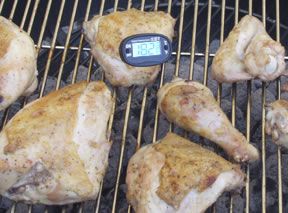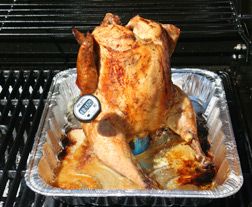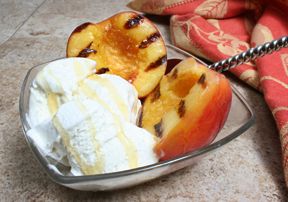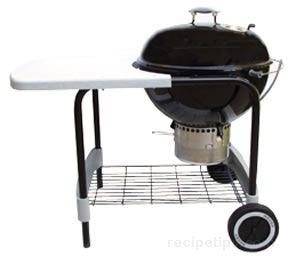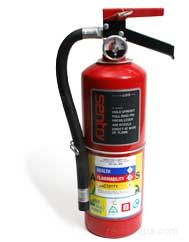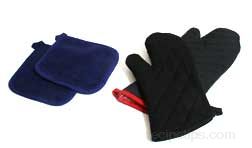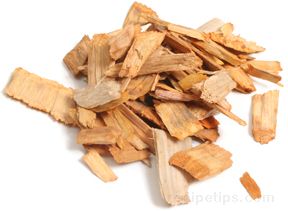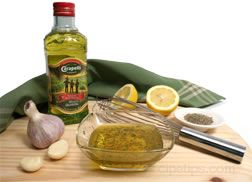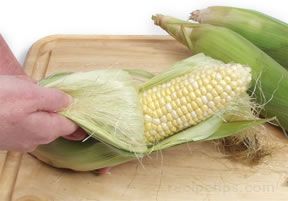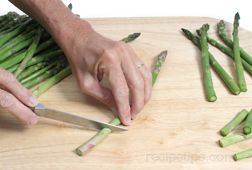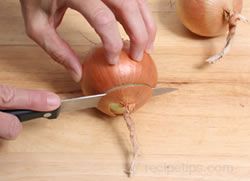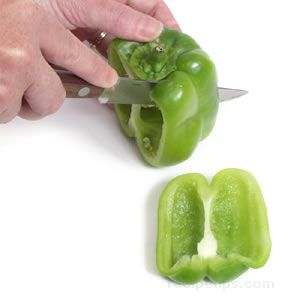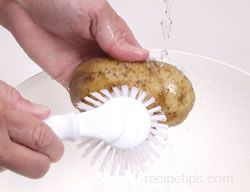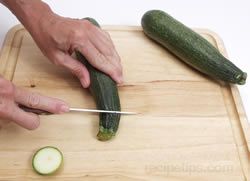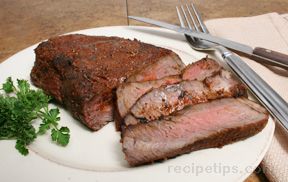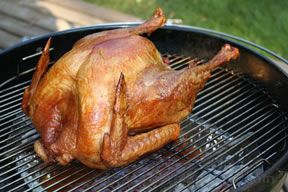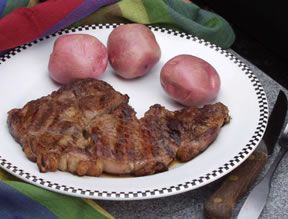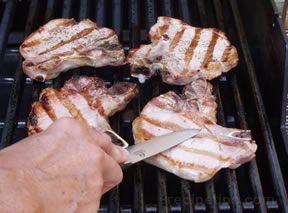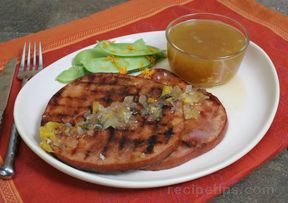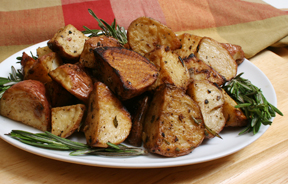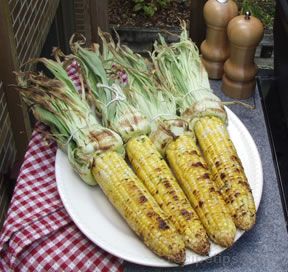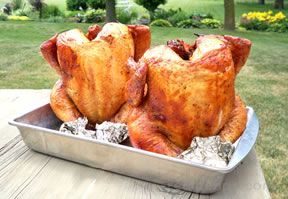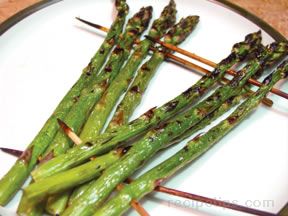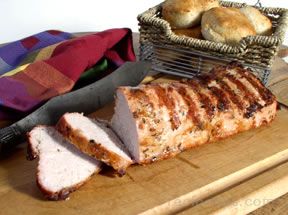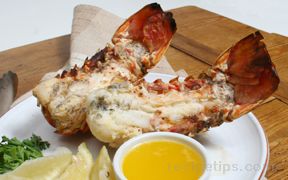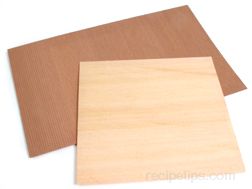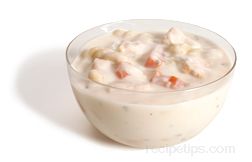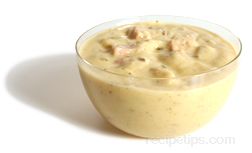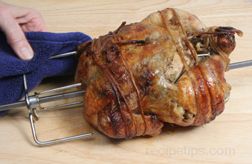|
| |||||||||||||||||||||||||||||||||||||||||||||||||||||||||||||||||||||||||||
|
Before grilling, check the size of the chicken pieces. Cut the larger pieces to smaller sizes so all pieces will cook more evenly. Flatten chicken breasts so that they are more uniform in thickness. | ||
|
If cooking a whole chicken, it should be butterflied for more even cooking. To butterfly, the backbone is removed, the breast bone is pressed down to flatten the chicken and skewers are used to help the bird lay flat by threading them through the breast and thigh area. For more information, see Chicken Preparation - Butterflying Chicken). |
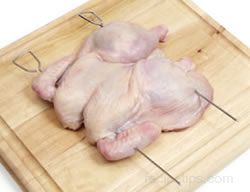 | |
|
| ||
Grilling
The grilling process cooks foods over a heat source, either directly, indirectly, or a combination of both. Grilling temperatures typically reach as high as 650ºF, but any temperature above 300°F is suitable as a grilling temperature. The high heat of grilling sears the surface of chicken, creating meat with a flavorful crust. The required cooking temperature and the method of grilling (direct, indirect, or a combination) depends on the size of the chicken or the pieces. It is important to cook the chicken to its proper doneness but not to overcooked.
There are many different types of grills available today that can be used when grilling chicken. For information on the different types of grills, see Types of Grills. It is important that the grill is set up properly and reaches the appropriate temperature for the type of chicken that is being grilled to ensure that it produces in a juicy, tender finished product that is cooked to the proper doneness. For information on setting up a charcoal or gas grill, see Outdoor Grill Preparation.
A medium heat should be used when grilling chicken. Using too high of a heat will cause some parts to cook too quickly and dry out while other parts will not be done all the way through. To check the temperature of the grill, see Estimating Heat Level to see how to use the palm of your hand for testing. The thicker the chicken pieces are the farther away from the heat source they should be or the heat source should be at a lower temperature to prevent the outside of the cut from burning before the inside is properly cooked. You will also have to decide whether you will use direct or indirect heat during the grilling time. Depending on the type of chicken, you may use both. A whole chicken or a thick piece, such as a full breast, may require direct heat to seal the outside and indirect to allow the cut to cook thoroughly to the center.
Indirect Heat
Cooking with indirect heat occurs when you use an area of the grill that is not directly over the heat source. Using indirect heat slows the cooking process down, which allows the center of the cut to cook thoroughly without burning the outside. On charcoal grills, coals are pushed to one side of the grill or banked into a ring around the outer edges. On gas grills, the side of the burner, which is below the area where the food will be placed, is turned off after the grill is preheated. Using one of the indirect setups will provide an area on the grill that is a low heat source. The meat is placed over the area in which there are no coals or over the burner that is turned off on a gas grill. Indirect heat is good for cooking whole chickens or larger pieces, such as a full chicken breast.
|
Indirect Heat Grilling on Charcoal Grills Once the chicken is prepared and the charcoals have been heated properly (see Charcoal Grill Setup), there are several easy steps to follow in order to cook chicken with indirect heat on a charcoal grill. | |
|
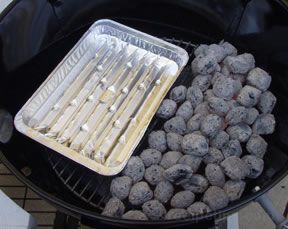 |
|
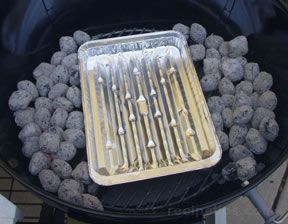 |
|
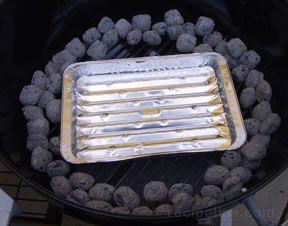 |
| |
|
Once the chicken is prepared and the gas grill have been heated properly (see Gas Grill Setup), there are several easy steps to follow in order to cook chicken using indirect heat on a gas grill. | |
|
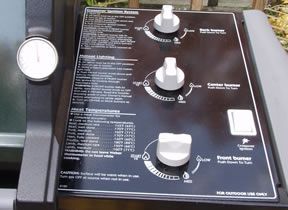 |
|
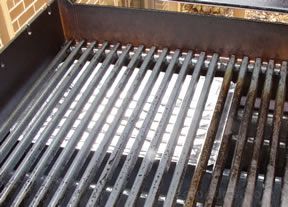 |
|
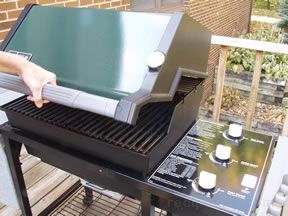 |
| |
Direct Heat
Cooking with direct heat occurs when you cook the meat directly over the heat source. The chicken is cooked quickly over medium or high heat coals or over burners set to medium or high heat on a gas grill. Direct heat is used when grilling food that cooks in 30 or less minutes, such as boneless chicken breasts and chicken pieces.
Direct Heat Grilling on Charcoal Grills | |
|
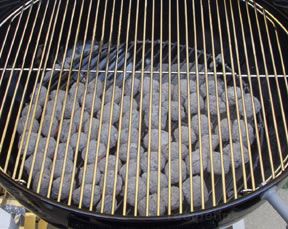 |
|
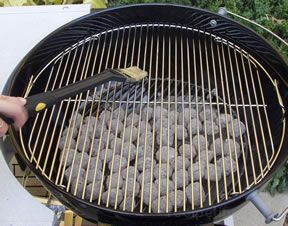 |
|
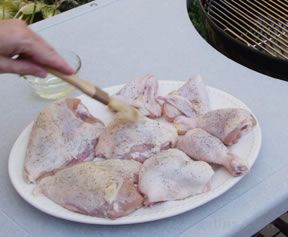 |
|
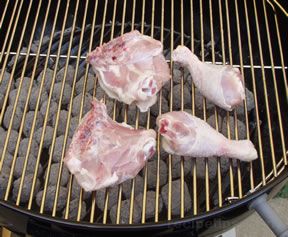 |
|
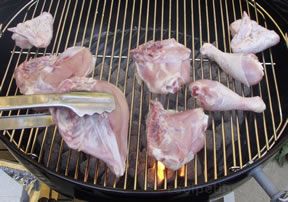 |
|
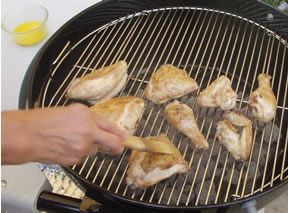 |
|
|
| |
Direct Heat Grilling on Gas Grills | |
|
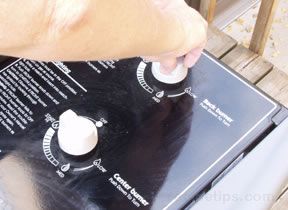 |
|
 |
| |
|
 |
| |
| Chicken Type | Grilling Method |
Grilling Time | Heat Level |
| Chicken Breast 5-6 oz | Direct | 6-7 minutes each side | Medium heat to prevent drying out |
| Chicken Legs | Direct | 15-22 minutes each side | Grill with chicken legs placed 5-6 inches above direct fire. Medium heat to prevent drying out. |
| Chicken, Whole | Indirect | 15-20 minutes per pound | Use medium heat to prevent drying out. Keep grill covered. |
Whenever possible, it is best to leave the skin on the chicken during grilling and broiling, If you prefer skinless chicken, remove the skin before serving. Leaving the skin on will provide a juicier, more tender piece of chicken and will not increase the fat content as long as it is removed before eating. If the chicken has already had the skin removed, coat it before cooking to prevent it from drying out. The chicken can be coated with cooking oil, a liquid marinade or any type of moist marinade.
The chicken must be checked for proper doneness when using either cooking method. The best way to check doneness is to use a meat thermometer. Ground chicken and chicken breast must reach 170°F. Whole chickens and other pieces should be 180°F. If a meat thermometer is not available, a visual test can be performed by piercing the pieces with a fork. If thoroughly cooked, the juices should run clear. Doneness can also be checked by cutting into the thickest part of the chicken and making sure the meat is opaque all the way through.
For more information on chicken, see Meat - Chicken.
Grilling Tips
- To prevent dryness, leave the skin on the chicken during cooking, which helps preserves the chicken's natural moisture.
- Be sure racks are clean and coat them with vegetable oil or a nonstick vegetable oil spray to help prevent sticking.
- When grilling, aromatic woods, such as hickory, mesquite or cherry, can be added to the preheated coals to give the chicken a distinctive flavor.
- Place smaller pieces of chicken around the outer edges, further away from the main heat source, to allow them to cook slower.
- Do not use a fork to turn the chicken as it cooks. The piercing causes the juices to escape.
- To speed grilling time, partially cook the chicken in the microwave first. Microwave on high approximately 4 to 5 minutes per pound, or 3 to 4 minutes if using cut up parts. Grill the microwaved pieces of chicken immediately to finish cooking.





